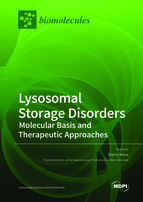Lysosomal Storage Disorders: Molecular Basis and Therapeutic Approaches
A special issue of Biomolecules (ISSN 2218-273X). This special issue belongs to the section "Molecular Medicine".
Deadline for manuscript submissions: closed (15 February 2021) | Viewed by 80350
Special Issue Editor
Interests: lysosomal storage disorders pathogenesis; Gaucher disease; mucopolysaccharidosis type II; developmental cell signaling; zebrafish; genome editing; axonal guidance regulation
Special Issues, Collections and Topics in MDPI journals
Special Issue Information
Dear Colleagues,
After decades of efforts and limited advances, our knowledge on the biology of lysosomes has lately been dramatically increasing, thanks to the application of novel technologies. The lysosome no longer appears to be a simple “waste disposal bag”, but rather a complex organelle with a plethora of important biological functions. Nonetheless, the growing body of knowledge on lysosomal storage disorders pathogenesis has led to a widespread awareness that alternative therapeutic approaches are required, beyond enzyme replacement therapy (ERT), in order to achieve the overall treatment of organ defects in affected patients.
In this Special Issue, we provide an updated state-of-the-art on lysosomal biology, with the integration of emerging concepts on lysosomal storage disorders’ pathogenesis and novel challenging therapeutic perspectives and avenues.
Prof. Enrico Moro
Guest Editor
Manuscript Submission Information
Manuscripts should be submitted online at www.mdpi.com by registering and logging in to this website. Once you are registered, click here to go to the submission form. Manuscripts can be submitted until the deadline. All submissions that pass pre-check are peer-reviewed. Accepted papers will be published continuously in the journal (as soon as accepted) and will be listed together on the special issue website. Research articles, review articles as well as short communications are invited. For planned papers, a title and short abstract (about 100 words) can be sent to the Editorial Office for announcement on this website.
Submitted manuscripts should not have been published previously, nor be under consideration for publication elsewhere (except conference proceedings papers). All manuscripts are thoroughly refereed through a single-blind peer-review process. A guide for authors and other relevant information for submission of manuscripts is available on the Instructions for Authors page. Biomolecules is an international peer-reviewed open access monthly journal published by MDPI.
Please visit the Instructions for Authors page before submitting a manuscript. The Article Processing Charge (APC) for publication in this open access journal is 2700 CHF (Swiss Francs). Submitted papers should be well formatted and use good English. Authors may use MDPI's English editing service prior to publication or during author revisions.
Keywords
- Substrate storage
- Autophagy
- Cell signaling
- Biomarkers
- Gene therapy







